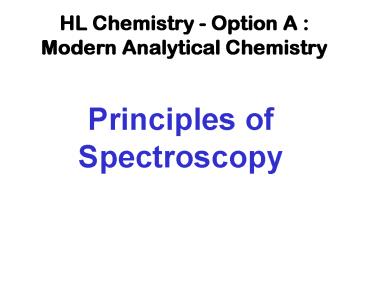Spectroscopy Overview - PowerPoint PPT Presentation
1 / 41
Title:
Spectroscopy Overview
Description:
Spectroscopy is an analytical technique which helps determine structure. ... CD can distinguish chirality. L-isomer D-isomer. pKa Measurement with UV ... – PowerPoint PPT presentation
Number of Views:81
Avg rating:3.0/5.0
Title: Spectroscopy Overview
1
HL Chemistry - Option A Modern Analytical
Chemistry
Principles of Spectroscopy
2
Definition
- Spectroscopy - The study of the interaction of
electromagnetic radiation with matter
3
Introduction
- Spectroscopy is an analytical technique which
helps determine structure. - It destroys little or no sample.
- The amount of radiation absorbed by the sample is
measured as wavelength is varied.
4
Major Types of Spectroscopy
- Infrared (IR) spectroscopy measures the bond
vibration frequencies in a molecule and is used
to determine the functional group. - Mass spectrometry (MS) fragments the molecule and
measures the masses. - Nuclear magnetic resonance (NMR) spectroscopy
detects signals from hydrogen atoms and can be
used to distinguish isomers. - Ultraviolet (UV) spectroscopy uses electron
transitions to determine bonding patterns.
5
Electromagnetic Spectrum
6
Electromagnetic Spectrum
7
Properties ofElectromagnetic Radiation
- Electromagnetic Radiation
- energy radiated in the form of a WAVE caused by
an electric field interacting with a magnetic
field - result of the acceleration of a charged particle
- does not require a material medium and can travel
through a vacuum
8
Transmission of Radiation
- Transmission
- rate at which radiation passes through a
transparent material is less than through a
vacuum - depends upon the kinds and concentrations of
atoms, ions, and molecules in the medium - radiation must interact with material
- interaction must not undergo permanent energy
transfer
9
Reflection of Radiation
- Reflection always occurs when radiation passes
from one medium to another - Reflection is greatest when two materials have
large differences in their refractive indecies
10
Scattering of Radiation
- Types of Scattering
- Scattering by Large Molecules
- can be measured
- a function of the size and shape of molecule
- Raman Scattering
- part of the radiation undergoes quantized
frequency changes - scattering involving molecules which are
considerably smaller than the wavelength of
radiation - blue sky results from greater scattering of
shorter wavelength visible light
11
Summary of the Type of EM Interactions
- Absorption - EM energy transferred to absorbing
molecule (transition from low energy to high
energy state) - Emission - EM energy transferred from emitting
molecule to space (transition from high energy to
low energy state) - Scattering - redirection of light with no energy
transfer
12
Atomic Absorption
- Absorption occurs with only a few well-defined
frequencies - Electronic excitation
- Several branches of spectroscopy are based on
this concept, a few of which are discussed here
13
Absorption vs. Emission
hn
En
En
hn
hn
Eo
Eo
Absorption
Emission
14
Absorption
15
Absorption of Radiation
- The energy of an exciting photon must equal
the energy difference between the ground state
and one excited state for absorption to occur
Quantum Leap
16
The Spectrum and Molecular Effects
gt
17
Fluorescence (Emission)
18
Emission of Radiation
- Radiation results from the relaxation of
electrons from higher (excited) states to lower
energy states - Emission Spectroscopy and Fluorescence
Spectroscopy are based on this concept
19
Equation Definitions
- E energy (Joules, ergs)
- c speed of light (constant)
- l wavelength
- h Plancks constant
- n nu frequency (Hz)
- nm 10-9 m
- Å angstrom 10-10 m
20
Key Formulas
- E hn
- h 6.626 x 10-34 J-s
- n frequency in Hz, E energy
- l c/n
- c 3.0 x 108 m/s
- l wavelength, n frequency in Hz
21
Visible Light
22
Visible Light
Red Orange Yellow Green Blue Indigo Violet
R O Y G B I V
700 nm 650 nm 600 nm 550 nm 500 nm 450 nm 400 nm
23
Complementary Colors
Absorbed Observed
24
Major Types of Light Spectroscopy
- Absorption spectroscopy
- Measures amount of light absorbed
- Most common, non-destructive
- Concentration, pH measures, purity, ID
- Atomic emission spectroscopy
- Measures light emitted from burned sample
- Elemental analysis
25
Types of Light Spectroscopy(continued)
- Fluorescence spectroscopy
- Samples fluoresce when they emit at higher l than
what they absorb - Measures solvent interactions, distances,
molecular shape, and motion - Circular Dichroism spectroscopy
- Absorption of circular polarized light
- Chiral compound identification
- Transmission spect. (colorimetry)
26
UV vs. IR vs. NMR
- UV has broad peaks relative to IR NMR
- UV has less information than IR NMR
- UV spectra are easier to collect
- UV spectra are faster to collect
- UV spectrometers are cheaper
- UV spectra require only nanograms of material or
chemicals
27
Single Beam Spectrophotometer
28
Dual Beam Spectrophotometer
29
Cuvettes (sample holder)
- Polystyrene
- 340-800 nm
- Methacrylate
- 280-800 nm
- Glass
- 350-1000 nm
- Suprasil Quartz
- 160-2500 nm
30
Definitions
- Io intensity of light through blank
- IT intensity of light through sample
- Absorption Io - IT
- Transmittance IT/Io
- Absorbance log(Io/IT)
Io
IT
31
Absorbance Beers Law
Increasing absorbance
32
Beers Law
Io
IT
Io
IT
pathlength b
pathlength b
33
Beers Law
Absorbance ebC
34
Absorption Methods
- Readout for an inexpensive photometer.
transmittance scale is linear absorbance scale
is exponential.. thus, one usually reads
transmittance, then calculates absorbance
35
UV Activity
- Needs chromophores
- CC, CO, NN, NO2,
- p -gt p and n -gt p transitions
- napthoquinones, anthocyanins
- Non-absorbers
- long chain aliphatics
- alcohols, ethers, non-conjugated mols.
36
UV Activity
hn
p
p
37
EM Radiation
E
M
38
Circular Polarization
39
Circular Dichroism
40
CD can distinguish chirality
L-isomer D-isomer
41
pKa Measurement with UV
n
i
Titration of Phenylephrine
Ai - A
pKa pH log
A - An

